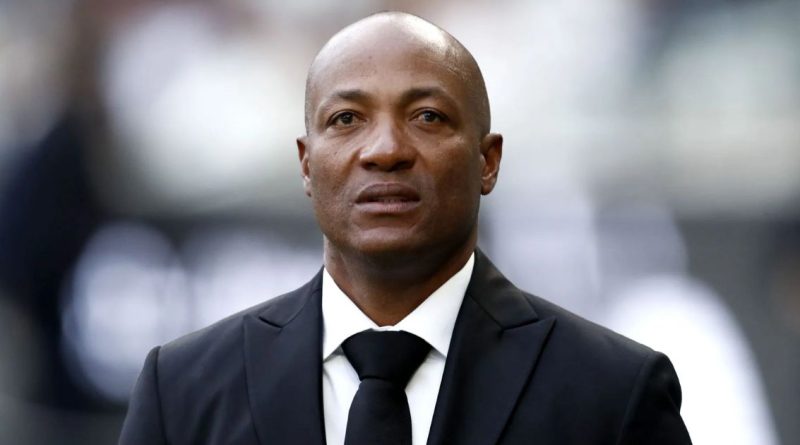Brian Lara: ‘West Indies have some of the best but talent isn’t everything’
Cricket legend Brian Lara shares his pride in the young West Indies team set to face England at Lord’s with Taha Hashim.
Joy fills Lara’s voice, not the simple, childlike kind but a deeper, rediscovered joy laced with past pain. “Young, inexperienced, written off,” he declares in the commentary box as Shamar Joseph, the tenacious fast bowler with an injured toe, celebrates with his teammates.
“This West Indies team can stand tall today, West Indies cricket can stand tall today.” They’ve achieved their first Test win in Australia since 1997.
Lara’s words from the Gabba in January were among the most moving, the cricket icon visibly emotional over the unexpected victory. “When you’re in Australia, you know there’s going to be a bit of arrogance [from Australia],” he says. “On the final day, they thought it would be an easy task. I was just so proud of these young cricketers. Twenty-seven years it took us to win a Test match in Australia. I couldn’t be a happier West Indian.”
History holds great significance for Lara. Growing up in Trinidad, he balanced books with his bat, reading about regional heroes: George Headley, Learie Constantine, the three Ws – Weekes, Walcott, Worrell – and Garfield Sobers. His interest wasn’t limited to cricket. Born seven years after Trinidad and Tobago gained independence, Lara was well-versed in British colonial history.
“You learn a lot about England’s history, not just on the field but off it. When you face something like that and know past battles, you understand the importance of stepping out in your West Indies colors against England. It’s more than just a cricket game.”
Lara’s matches against England cemented his legend, a key focus of his new autobiography, Lara: The England Chronicles. In April 1994, he broke Sobers’s record for the highest Test score with an unforgettable 375 against Michael Atherton’s team in Antigua. Soon after, he scored an unbeaten 501 for Warwickshire against Durham, a first-class record. In April 2004, he scored 400 not out against Michael Vaughan’s side in St John’s.
The 375 held special significance. “It was more hair-raising, more emotional,” he recalls. “Remember, I was 24, trying to make a name for myself.” Lara started the day unbeaten on 320 after a sleepless night, his restlessness driving him to play golf before breakfast. A pull through midwicket took him past Sobers’s 365, sparking a fanatical pitch invasion.
“Men lying on the turf, crying, shouting,” Lara recounts in his book. “Hundreds, all trying to touch me. It was chaos.”
Matthew Hayden’s 380 for Australia against Zimbabwe in October 2003 surpassed Lara. Yet, six months later, Lara reclaimed the record, not driven by the numbers but by a desire to avoid a whitewash in the series with England leading 3-0.
“I had 100 runs in six innings, we’d lost three Test matches. I was captain again in 2003, focused on being better than before. My mind wasn’t on breaking records.” But to achieve it again at the same ground against the same team? “I believe it’s destiny.”
The book, detailing Lara’s international career from the early 90s to the mid-2000s, is particularly revealing about his formative years, which overlapped with Viv Richards’s farewell. In 1991, during a tour of England, Lara essentially became Richards’s chauffeur, driving him between grounds in a Vauxhall Calibra. It was a tough education, filled with reprimands and icy glares. Yet, Lara stayed close to Richards, knowing the value of learning from the great.
Lara inherited Richards’s role as the team’s central figure, but individual brilliance didn’t translate to collective success. By 2004, England, long dominated by the West Indies, emerged victorious in seven of eight Tests that year. The pace and ferocity of Andrew Flintoff and Steve Harmison reminded Lara of what his team had lost.
“We lost focus,” he says. “We had the best team for 15, maybe 20 years. The world learned from us. They valued fitness, embraced technology, tactical moves, and formed academies.
We relied on natural talent, believing the next Viv Richards or Curtly Ambrose would appear. That’s not how cricket works today. I still believe we have some of the best talents in the world, but talent alone isn’t enough.”
Lara sees potential in young fast bowlers like Joseph, Alzarri Joseph, and Jayden Seales but worries about the inexperienced batting lineup ahead of three Tests in England. He’d prefer a more aggressive approach.
“Everyone wants to see Nicholas Pooran in a Test match. I’m not sure if he was asked or what the situation is. I’d love to see Shai Hope back in the West Indies team. But we have to work with what we have: young players eager to play for West Indies, eager to play Test cricket. Hopefully, their style will shine, and they’ll find success.”
Lara reflects on his own career. “I was meant to keep the West Indies on top of the world and I couldn’t do it,” he writes. “I failed at my main purpose.”
But not all is lost. “In my book, I also ask if I entertained,” he says. “If I couldn’t keep the West Indies at the pinnacle, did I at least entertain the fans? That’s important to me.”

